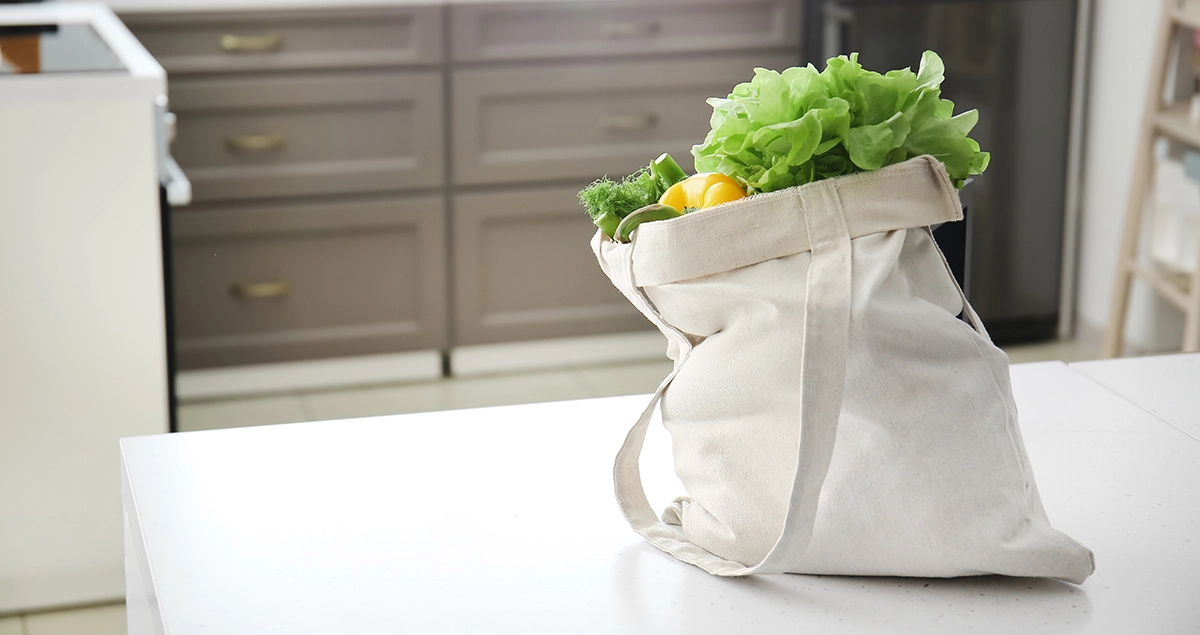5 Easy Ways to Protect the Environment (from within your kitchen)

While we all have noble aspirations of protecting the environment, sometimes it’s hard to know where or how to start. One of the simplest ways to begin is by making small changes at home. Employing eco-friendly habits at home is something you can do with minimal effort, but which will have a maximum impact on our planet at large. The kitchen is an area where there are so many opportunities to make a positive impact since a lot of waste and pollution happens here. Read on to discover simple yet effective ways you can protect the environment from within your own kitchen!
1. CHOOSE REUSABLE ITEMS

Plastic is so commonplace in home kitchens that many of us overlook it and the potential hazard it poses on the environment. More than 381 million tonnes of plastic was produced globally in 2015, and future projections forecast that by 2050 there will be more plastic in the sea than fish. In Singapore, about 900 million kilograms of plastic waste is discarded every year with less than 10 percent recycled.
Aside from the obvious products such as plastic rubbish bags, items like plastic drinking straws and plastic cutlery also make up the non-biodegradable products making up almost half of all plastic waste.
HOW TO CHOOSE BIODEGRADABLE OR REUSABLE ITEMS
One of the most effective things you can do right now to reduce the use of plastic is by choosing biodegradable or reusable items wherever possible. These items could include reusable cutlery made from eco-friendly packaging, or a ‘keep cup’ to store your coffee in on your way to work instead of using or purchasing one-use coffee cups. When it comes to shopping, invest in a tote bag and say ‘no’ to plastic bags at the supermarket aisle. Better yet, why not purchase your fresh produce from your local farmer’s market?
KOKA’S TOP THREE TIPS
- Use Reusable Coffee Cups – When you go to buy a cup of coffee, rather than getting it in a plastic cup from the store, bring your own reusable cup to be filled up. Some stores might even offer small discounts when you bring your own cup!
- Unique Bamboo Straws – Everything about bamboo straws is awesome! They’re sustainable, eco-friendly, look cool, and are handy. You can carry one wherever and whenever you’d like to take a sip!
- Packaging-free Shopping – Zero-waste shopping is strongly recommended in Singapore, that’s why packaging-free stores were introduced and opened for consumers to reduce the use of plastics and keep up with the consumers’ budget at the same time. Keep your containers at home. Bring them when you go shopping at one of the Packaging-free stores near you. Refill those containers of shampoo, moisturizers, soaps, toothpaste, etc, and you’ll use less plastic than ever before.
2. CUT DOWN WATER USE

We often neglect to think about how our water use can contribute to resource and energy waste. On average, Singaporeans use about 151 litres of water per day with 22% of this usage coming from the kitchen. A large chunk of this number comes from dishwashing, with handwashing dishes using an average of 40 litres each time – over 5 times more water than using a dishwasher!
HOW TO SAVE WATER IN THE KITCHEN ITEMS
When it comes to washing your dishes, make sure that your dishwasher is fully loaded before turning the dishwasher on. For those without a dishwasher, avoid filling the kitchen sink all the way up. Use a centimetre or so of hot water followed by some cold water and wash using eco-friendly detergent. Scraping food waste into a compost bin is a good alternative to pre-rinsing dishes. A clever way to curb your water use is by reusing your cooking water. If you steam or boil vegetables, often the leftover water goes down the drain. Instead, save the water and use it to start a stock for soup. Also, be sure to wash your vegetables in a pot of water instead of under a running tap in the sink.
KOKA’S TOP THREE TIPS
- Defrost Differently – Many people like to use running hot water to defrost their frozen foods, but this can result in a lot of wasted water. Consider defrosting foods in the refrigerator overnight or during the day, or use a microwave when you’re in a hurry.
- Beat the Pressure – It’s just a small issue, but it might cause more significant problems in the long run. Intense water pressure apparently leads to wasted water- gallons of it! It could also cause damage to pipes, resulting in leaks – that means more wasted water (uh oh). Installing water-pressure-reducing valves are the best recommendation to prevent all of these problems.
- Scrape the Scrap – Most of the time, we rinse our dishes on a running tap, which is a big waste of water. Instead, scrape off leftover food and save it, or put it in a compost bin.
3. REDUCE FOOD WASTE

Food waste is one of the biggest waste streams in Singapore, with 763 million kilograms of food waste produced in 2018 alone. Food waste poses a problem to our environment as it puts pressure on our resources, forcing us to build more waste disposal facilities than we can keep up with. Kitchen food waste is one of the biggest contributors since the majority of our food preparation and disposal happens there.
HOW TO MINIMISE YOUR KITCHEN FOOD WASTE
To minimize food waste from within your kitchen, you can start by becoming more economical. For example, you can use leftover chicken and vegetables from last night’s dinner and make a stock. You can also use food scraps in a home compost bin or garden bed and also freeze leftover meals and even fruits like ripe bananas to use in the future for smoothies and desserts. Another way to reduce food waste is by choosing products with long expiry dates. Many people are unaware that common food items like eggs often remain good for three to five weeks beyond their expiration date.
KOKA’S TOP THREE TIPS
- Peelings to Fertilizers – All the unwanted parts of fruits and veggies doesn’t deserve its ultimate doom in the trash. Peelings and other excess parts can be converted into fertilizers for your plants at home. Just dry them up, chop them into bits, and add it to the crops – Simple and it rhymes!
- Segregate. Create. Repeat –Food waste can be transformed into various potential uses when segregated and treated properly. It can be converted into animal feed and compost for landscaping. Singaporeans are highly encouraged to learn food waste segregation nowadays.
- Hand over the Leftover –Food waste management encourages people and local businesses in Singapore to donate unsold or excess food by linking them to food distribution organisations and food banks. It might be a big help to somebody, rather than throwing it in the trash.
4. CHOOSE LESS PROCESSED FOODS TO LOWER CARBON EMISSIONS

Did you know that some of the foods you eat have their own carbon footprint? Emissions from farming, transportation and even gas produced by cows used for beef all contribute to global warming. Common food staples found in the kitchen such as bread also carries its own carbon footprint; with white medium sliced bread in a paper bag having the highest footprint compared to other bread types. This is because the more processed a food item is, the more energy is required to produce it. This leads to more carbon emissions polluting the atmosphere.
HOW TO REDUCE YOUR CARBON FOOTPRINT
One swap you can make today is by choosing food items that are higher in wholegrains. These foods require less processing and are particularly climate-friendly since cereal crops are energy-efficient. In addition to preparing your meals with more wholegrains, be mindful of the amount of meat used and consider sometimes adding vegetables to your noodle dishes instead.
KOKA’S TOP THREE TIPS
- Whole Grain, Less Gain – Brown rice, red rice, buckwheat, whole corn/maize, rolled oats, oatmeal, and a few more are considered full-grain options that are rich in fibre – with zero gluten, sugar, and cholesterol. These foods are a perfect aide for weight loss, lessening the risk of having diabetes and heart ailments.
- From Boring to Appetizing – Some people may not be a fan of healthy foods, assuming that they may be boring, or not look appetising. That’s why it’s important to put your twist on it! A lot of health gurus and food bloggers nowadays are sharing simple yet delicious healthy recipes online. Get inspiration from them and experiment as well. Turn those healthy ingredients into a wonderful bowl of awesomeness.
- Go Organic, Don’t Panic… – Incorporating more fresh produce – from dairy and fruit to meat – into your diet is a great way to be healthier and reduce your carbon footprint. There’s nothing to worry about organic food since it went through a minimal and more natural process without artificial ingredients and synthetic preservatives. It’s also typically fresher, meaning it has been kept in cold storage for less time helping to reduce carbon emissions.
5. USE ENERGY-EFFICIENT APPLIANCES

The kitchen is home to most of our energy-hungry appliances. Ovens, refrigerators, dishwashers and even kettles & toasters all consume a lot of energy. This energy use can contribute to air pollution as well as poison eco-systems when appliances are disposed of at the end of their life cycle.
You can help cut energy use by choosing energy-efficient appliances which carry the energy-efficiency rating label. This is particularly important when it comes to fridges since they are constantly running.
HOW TO CHOOSE ENERGY-EFFICIENT APPLIANCES
One of the challenges of choosing energy-efficient appliances is the cost. While comparing the upfront cost of ‘green’ appliances compared to traditional appliances, it is true that they are generally more expensive. For example, fridges with 3 ticks cost about S$200 more than a 2 tick refrigerator. However, long-term running costs will work out cheaper with an energy-efficient appliance. Another thing to consider is the way you use your appliances. Microwave ovens, for example, use less energy than cooking food in an oven, so instead of warming up food items in the oven, you can switch to the microwave to reduce energy waste.
KOKA’S TOP THREE TIPS
- Look for the Green Ticks – When shopping for new energy-efficient appliances, look for this label (sticker), usually placed in every appliance sold in the market. The green tick (green check) indicates the energy efficiency rating of an appliance. 4 green ticks mean excellent, while with only one tick is poor.
- E-cooking – While most culinary experts prefer gas for preparing food, electric cooktops and ovens are more sustainable for the home kitchen. These are the most efficient especially if you have a renewable energy system in your region.
- Go for Smart Kitchen Appliances – In today’s ultramodern breakthroughs, smart kitchen appliances are one of the greatest inventions. These devices make food preparation, cooking, kitchen maintenance, and food storage more fun and convenient. Best of all, these modern appliances help lessen energy consumption dramatically because of its energy-efficient features.
CHOOSE KOKA NOODLES
You can still enjoy your favourite snack while doing your bit for the environment. Many of our noodles are steamed & baked instead of fried, and are much higher in wholegrains and have longer expiry dates than other typical snacks in your cupboard! Enjoying your KOKA noodles is simple, just prepare by using an energy-efficient kettle with a small amount of water. Discover the KOKA Multigrain Oats & Barley and KOKA Multigrain Purple Corn products to snack smarter with our healthy noodles that are also healthy for our environment!
